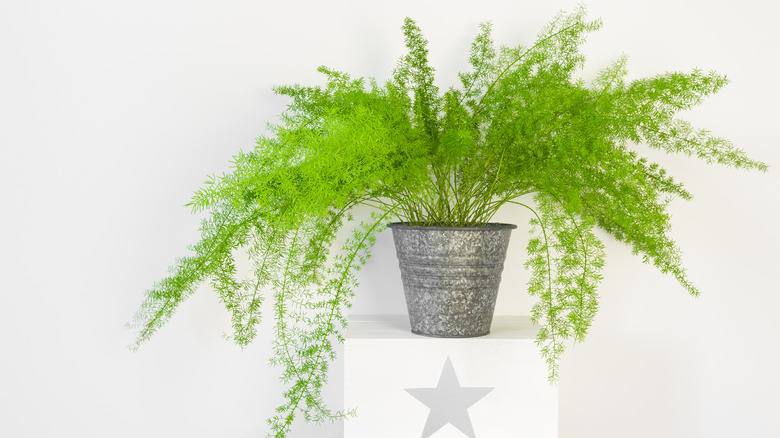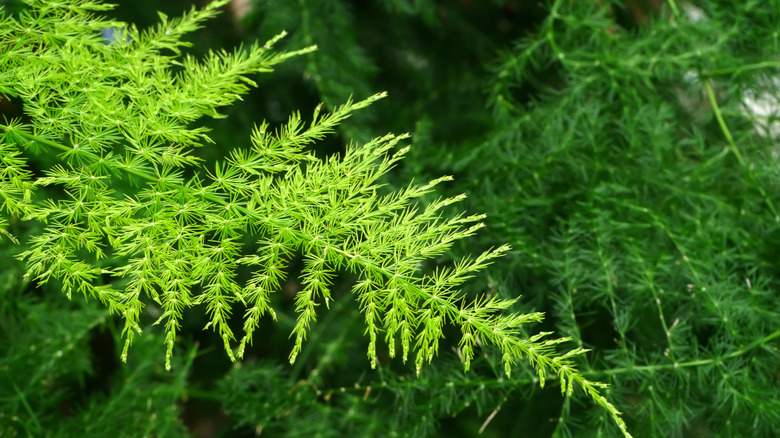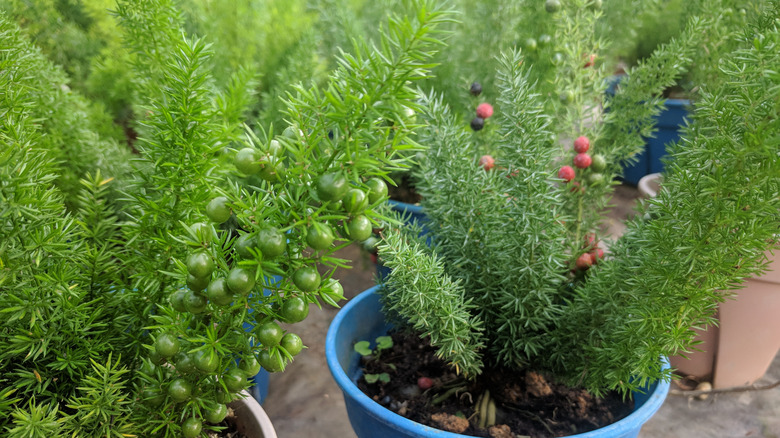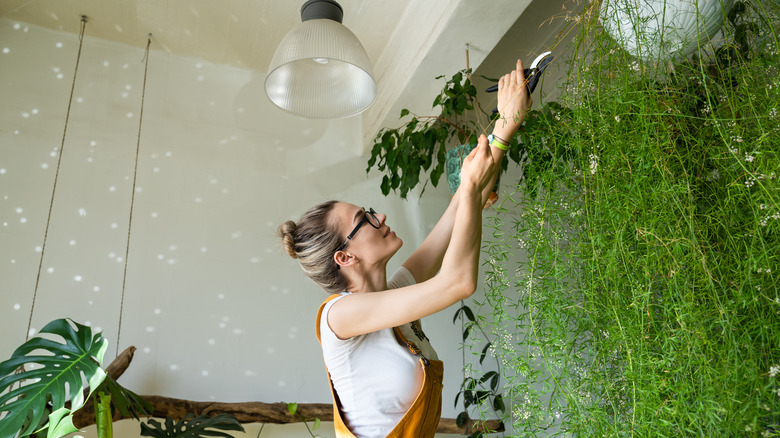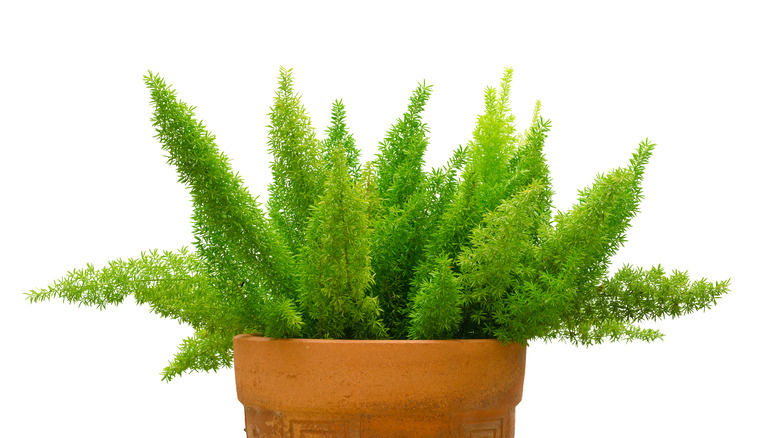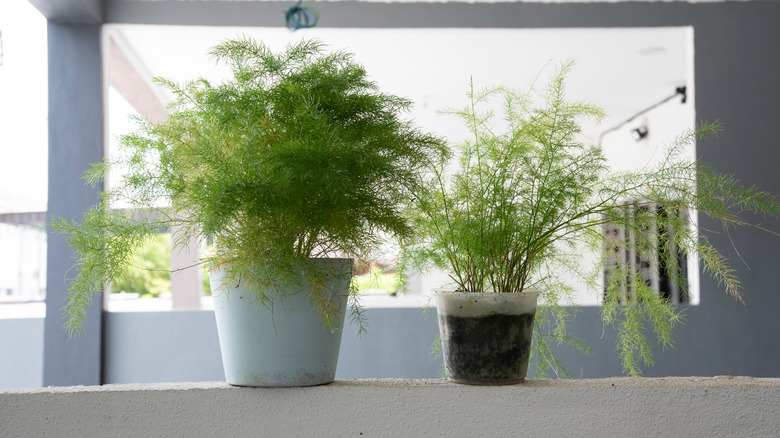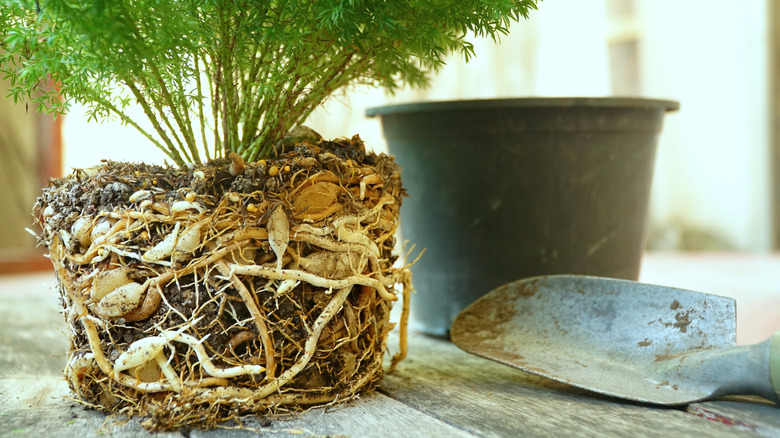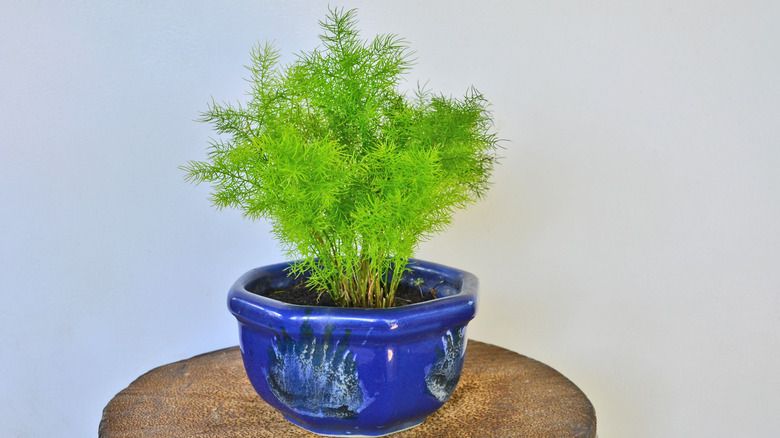How To Successfully Grow An Asparagus Fern
The asparagus fern, or asparagus aethiopicus, is a feathery, bushy plant most commonly seen in hanging baskets outdoors, but it also functions well as a houseplant. This easy to care for plant is actually not a fern at all, but a relative of lilies, according to The Spruce. Native to South Africa, the asparagus fern is also commonly known as the emerald fern, emerald feather, or lace fern (via Gardenista). Despite its fluffy names and delicate appearance, older plants can become woody and sharp, even producing spurs, per Gardening Know How. The feathery leaves are actually not leaves at all, but branches called cladophylls.
Asparagus fern is easy to maintain both indoors and outdoors, though both circumstances will provide some challenges. The asparagus fern is a quick grower, and as such is classified as an invasive species in certain areas. Indoors, it can be prone to common houseplant pests. Despite its drawbacks, this plant can be an excellent addition to your outdoor or indoor space should it be properly cared for.
How to use asparagus fern in garden
The asparagus fern is popularly found in hanging baskets or large outdoor containers, though it can be planted, too. However, if you would like to plant an asparagus fern outdoors in a garden, there are a few preliminary concerns. One, make sure it isn't considered an invasive species where you live. Due to its quick growing nature, it's considered an invasive species in Florida, Hawaii, and Texas (via the University of Florida). It is also toxic to humans and animals, so keep that in mind when deciding where to plant your asparagus fern. It does best in USDA hardiness zones 9-11, which includes much of California, Florida, and Hawaii, and parts of Arizona and Texas. In colder climates, you can keep your asparagus fern in a pot or outdoor container, and bring it in for the winter. Per Bloomscape, if kept in the right conditions, the asparagus fern has the potential to flower, or even produce berries! They are not meant for consumption, but can be used to plant more asparagus ferns.
When planting in the ground, you should plant asparagus fern in slightly acidic soil, preferably with a pH balance of 6.5 to 6.8. It should be kept in part sun to part shade, well-watered, and fertilized in warmer months, and occasionally pruned (via Gardening Know How). Follow these same guidelines if you're bringing your potted asparagus fern outside during the summer.
How to grow asparagus fern
The asparagus fern can be grown in a couple ways, either by planting seeds found in its berries, or propagating the plant. The easiest option is propagation, since the plant is fast growing and the berries may be difficult to cultivate. Propagation should be done during repotting; per The Spruce, dig up the plant and separate the tuberous roots. Replant each root in an individual pot and care for it as usual.
If you would like to grow your asparagus fern from seed, begin by soaking your seeds overnight. Add your soaked seeds to starter pots filled with moistened, slightly acidic soil. Lightly press them into the dirt and cover with just a little more soil (via SFGate). Keep them next to a bright window and keep lightly moist until they sprout — about four weeks. Transfer to a pot or outdoors once germinated, ideally in the early spring or cooler, not cold, weather.
How to care for asparagus fern
Caring for an indoor asparagus fern is an easy task. It is a pretty resilient plant, but it will thrive best when you mimic its natural growing conditions as best as possible. The asparagus fern grows naturally in dappled shade, and you should aim to recreate this as best as possible. South facing windows should be avoided, says Plant Index, as the only light conditions that will be detrimental to your plant are bright, direct rays from the sun. The leaves will turn yellow if it is receiving too much light, so feel free to move it around until it's happy.
One of this plant's care quirks is its need for humidity. Make sure to keep the soil moist, but not soggy. More importantly, make sure to provide this plant plenty of humidity. Most indoor environments will be too dry for this plant, and you should take care to mist your plant daily. The asparagus fern needs fertilizer, but can suffer from being overfertilized. Feed with a diluted liquid fertilizer bi-weekly to monthly from spring to early fall, more during the summer, and stop feeding during its dormant months.
Varieties of asparagus fern
There are a handful of varieties of asparagus ferns with slight physical variations and care needs. While the feathery look of the asparagus fern makes for a beautiful addition either outdoors or inside, the plant's varieties can provide slight visual alternatives for your spaces.
Here's just a few of these varieties from Leafy Place:
-
Foxtail Fern — This variety gets its name from the tail-like, separated appearance of its leaves. It's drought resistant, and can be grown indoors and outdoors similarly to the asparagus fern.
-
Sprenger Asparagus Fern — The Sprengeri Fern sports a dark, emerald color and needle-like cladophylls, and is less feathery than the regular asparagus fern.
-
Asparagus Plumosa Fern — This variety can grow up to 20 feet long, and produces bell shaped flowers and black berries.
-
Ming Fern — Ming Ferns are much more needle-y than the asparagus fern, and can grow up to 8 feet tall when planted outside.
-
Climbing Asparagus Fern — As the name suggests, this variety can climb up trellises or be used as ground cover, and doesn't sport the thorny, sharp stems of its counterparts.
Is asparagus fern toxic?
Yes, the asparagus fern is toxic. While happy plants produce berries, they should under no circumstance be consumed by humans or animals. The ASPCA warns against both dermatitis from repeated contact, and gastric upset if ingested. If you suspect your pet has ingested your asparagus fern, watch for vomiting, abdominal pain, and/or diarrhea. Contact your local vet immediately if your pet has ingested the leaves or berries from this plant.
According to SFGate, both the asparagus fern's leaves and berries contain steroidal saponins, which is what triggers both gastric upset and skin irritation. They warn that your pet may need to be put on an IV due to possible dehydration, as well as prescribe topical cream to aid in skin irritation. Take care to keep your indoor asparagus ferns out of reach of animals and children. Consider putting netting around outdoor asparagus ferns, as cats and other animals may be inclined to rub against the plant or chew on it.
How to repot asparagus fern
The Spruce says that asparagus ferns can tolerate being somewhat rootbound, and as such you should only need to repot your plant every two years. Repot your plant in the spring for best results. To begin repotting your asparagus fern, remove it from its current pot and break up and divide the roots. The roots are tubular, and can easily be separated. Each root can be planted in an individual pot. Your pot should not be too small, as the roots will begin to grow up through the surface if the plant is not given ample space.
Your soil should be well draining. Plant Index suggests finding a soil mix with compost, bark, clay, perlite, and/or coco fiber. You can also purchase these materials separately and combine them with a basic soil to create your own mix. Add your root to your pot and cover with soil and water.
Avoid scale insects on your asparagus fern
While the asparagus fern is not prone to insects or diseases by nature, indoor plants require moist, humid conditions, which can attract a variety of insects. Spider mites, aphids, and mealy bugs will be attracted to your asparagus fern, as noted by The Garden Helper.
There are a few ways to avoid and/or treat this problem. One, give your asparagus fern a regular shower. Simply place your plant in your shower on a gentle setting, and let lukewarm water wash away old dirt and dust, which can attract bugs. This will also wash away any existing bugs. You should also routinely wipe down the plant's leaves with a neem oil solution (via HousePlantHouse). Do this with a microfiber cloth, as other materials can clog your plant's pores and cause further issues. Keep an eye out for white webs and brown spots. If you notice bugs on your plant, immediately quarantine it away from other plants to prevent further spread.
